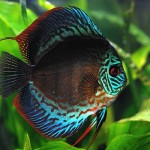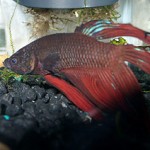Betta fish, also called as the Siamese fighting fish make wonderful pets.The brilliant coloration, and long flowing fins of the Betta make it one of the most well known of aquarium fish. Colors range from red to blue to white. Females are not as highly colored, and have much shorter fins. A well conditioned breeding female will often display horizontal stripes.
Although many fish keepers are aware that Bettas come from shallow waters, a key factor that is most often overlooked is the water temperature. These countries are tropical, which means the water temperature is quite warm – often reaching into the 80′s. Bettas thrive on heat, and will become increasingly listless when the water temperature falls below 75 degrees F. So Make sure the jar or bowl that you keep your Betta in is big enough so that he can swim around and not bump or lacerate his fins or scales. furthermore be sure there is plenty of surface area so that he can procure enough oxygen.
Observe how your betta fish responds to its new surroundings over time, once you bring it home. This will enable you to find out if they have adapted to the new environment.
Do not put your Betta fish with supplementary Betta’s. They are called Siamese fighting fish because they are, in nature, fighting fish. They can slash at one another, often causing the death of at least one fish before they stop. Betta’s can be double with algae eaters, guppies, or corydorus catfish safely.
Betta Fish Care is not something that is to complicated to follow.Even though Bettas do well in waters low in dissolved oxygen, that does not mean they require less oxygen than other fish. Bettas have a special respiratory organ that allows them to breath air directly from the surface. In fact they inherently must do so. In experiments where the labyrinth organ was removed, the fish died from suffocation even though the water was saturated with oxygen. For this reason, Bettas must have access to the water surface to breath air directly from the atmosphere.Optimally the water for keeping healthy Bettas should be soft, warm, with a neutral to slightly acidic pH.
Your Betta is a meat eater and likes live foods, such as brine shrimp the top. frozen bloodworms are besides a good alternative for your meat eater. Most Betta fish readily eat the Betta pellets sold at most domestic stores.
These tips for caring for your Betta fish will help you have a healthy looking betta fish.Check out for forums, groups or the library for more information incase you need to learn more about your betta fish.

















Leave a Reply